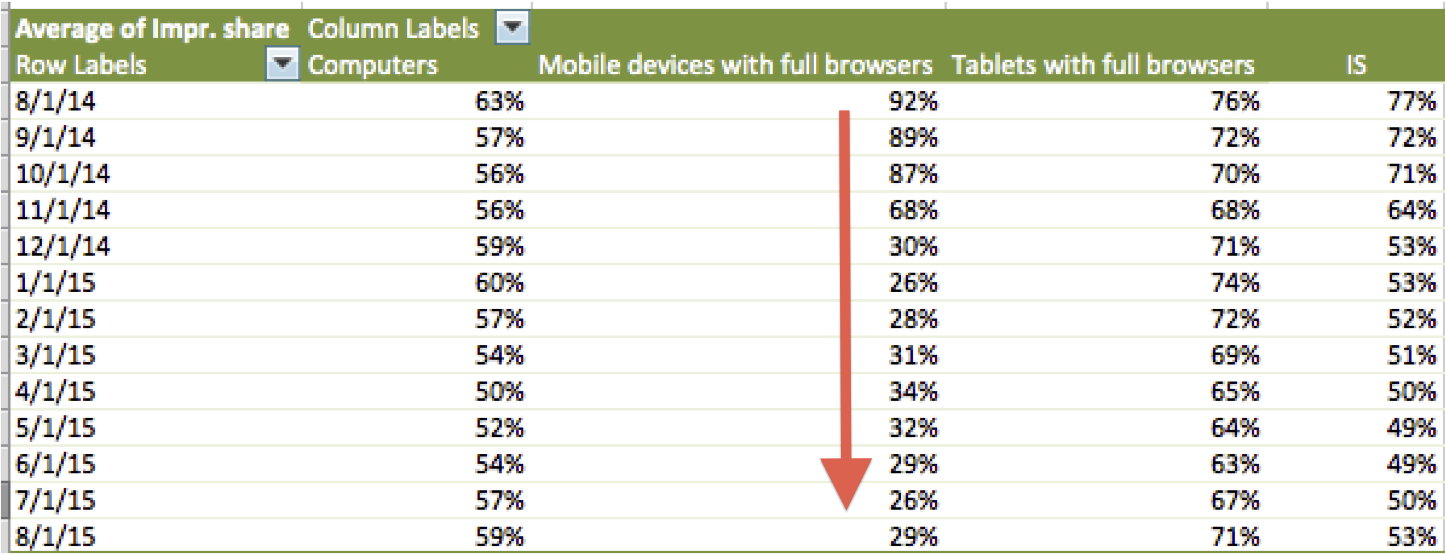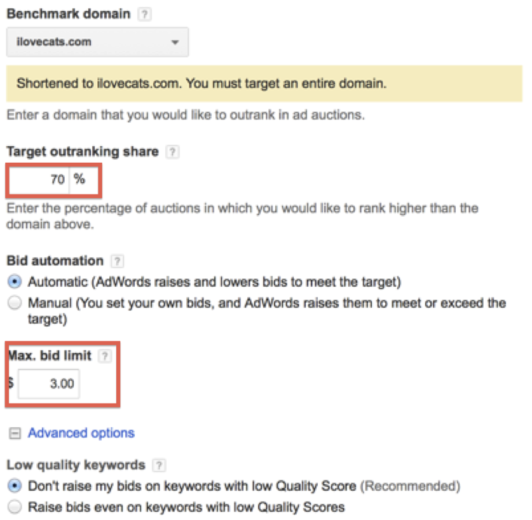Analyzing the PPC competitive landscape can help provide key insight into performance trends and determine how your ads stack up to competition. By not taking the time to analyze PPC competitors, you could be missing out on huge gaps in your program that could leave your account vulnerable to deep-pocketed competitors driving up costs and stealing impression share. Below, we will discuss 5 steps for how to find your true PPC competitors and provide strategies for how to stay profitable.
Determining PPC competition and creating strategies to compete can be challenging due to the fact that PPC advertisers are constantly entering and exiting the search auctions. Because of the fluidness of the search auctions, PPC managers need to regularly perform competitive analysis to keep abreast of the competitive space.
For example, you could have a competitor with a big budget that decides to only advertise on your key terms in November during peak holiday rush. This situation then causes you to panic as you watch your ROAS and impression share plummet without reason. This is typically not “the norm” but it does happen and it’s important to stay aware of the competitive landscape so you can prepare and adjust your strategy. Before we can create a competitive strategy, we need to start with a competitor analysis and determine the competition.
1) Determine PPC Competitors
As I mentioned above, finding PPC competitors requires a little more work as search auctions are a living breathing beast. Fortunately, there are many tools available to help you with your competitive analysis. Below are just a few.
Of the tools above, I have found the Auction Insights report in AdWords and Bing to be the most accurate.
The Auction Insight report contains several different metrics including Impression Share, Position Above, Outranking, etc, to analyze competitor performance, but my favorite metric for determining true competitors over time is the Rank Above Share metric that Hanapin’s own Jacob Brown created. Rank Above Share takes impression share * position above rate to determine competitors over a period of time.
Once you’ve used the Auction Insight report to unveil who your true competitors are, the other tools are great for gathering information about ad creative, keywords, content and much more.
2) Competitors By Device
Another great feature about the Auction Insight tool is that it allows you to segment your competitor data by device and time. Now that desktop/mobile/tablets are all wrapped up into one campaign, you are getting an average across all the devices when looking at top-level data. This data can sometimes be misleading as you may not have the same competitors in mobile as you do on desktop. Rachael Law wrote a great post on how to segment auction insight data by device and why it’s important.
3) Track Competitor Trends
Now that you’ve pulled all the competitor data, it’s time to make sense of it. Viewing competitor data over longer periods of time helps identify trends, which can help when it comes to budgeting or strategic optimizations.
Graphs are a great way to help visualize these trends. However, if you are anything like me, creating graphs may just not be your thing. You are in luck! While AdWords does not have scripts available for Auction Insights just yet, but the folks at Brainlabs have come up with a handy script that is a great workaround for visualizing competitor trends based on the auction insight metrics and CPCs. The steps for implementing the script are fairly simple:
- Run AdWords Auction Insights report
- Run campaign report for same time period
- Create Google Sheet
- Paste Brainlabs Auction Insight script under Scripts editor -“Google Apps Scripts”
- Paste Auction Insights report on Sheet1 and Campaign Report on Sheet 2
- Watch data auto-populate into pretty graphs to monitor competitor trends over time
4) GAP Analysis – Content And Offerings
By this time you should have a pretty solid idea who your competitors are. Now it’s time to see how you stack up to your competition by focusing on these two key areas:
- Top Value Proposition
- Identifying GAPs in strategy
Top Value Proposition
Use the various competitor tools to review the content and messaging competitors are using. Create some sort of document (I prefer excel for pretty much everything) that allows you to track messaging across top competitors and see where your product or offering is superior and where it falls short.
Identifying Gaps In Strategy
Now that you’ve reviewed your competitors content and can see what your top value proposition is, next you want to identify areas that you are superior – or gaps in your’s and your competitor’s strategy. For example, you may notice that your competitors are running a sale but not free shipping and this is something your company offers. Highlighting those gaps could be beneficial in your messaging. You may also notice that your main competitor in desktop is not running in mobile, identifying an opportunity to gain more impression share at a lower cost.
5) PPC Competitor Strategies
Once you’ve identified true competitors, determined your top value proposition and are aware of gaps in PPC strategy, next it’s time to create a plan of attack. Below are two potential strategies for beating out the competition.
Target Outranking Share
Target outranking share is a bid strategy available through AdWords that allows you to create a rule for how often you would like to show above a specific competitor in search auctions. While this is definitely one way to make sure you stay ahead of a competitor, it can also be very costly. If you choose to use this strategy be sure to set max bids and remember that the higher the % of time you choose to show above the competitor the more money you will spend.
Gmail Ads Competitor Campaigns
Gmail ads are another way to target competitor terms without creating an all-out bidding war. This strategy allows you to target competitor terms directly in users gmail. These users are more likely to be higher in the funnel and theoretically more likely to convert.
We’ve tested this strategy out across a couple campaigns and results vary, but a couple takeaways we’ve seen is that these campaigns typically tend to have low volume (depending on the competitor), however, have higher conversion rates and lower CPAs compared to other display campaigns.
Another Gmail ads strategy I’ve yet to test yet but could see being a great way to make these campaigns more efficient would be to potentially layer these campaigns with remarketing lists. I feel a future case study coming on!
Final Thoughts
Don’t let pesky competitors turn you away from PPC due to heavy competition. Follow the steps above at least every 3 to 6 months to stay abreast of the competitive landscape and constantly be looking for new ways to compete more efficiently in the PPC space.








